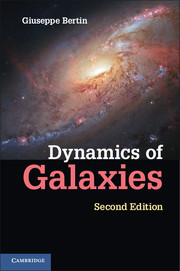Book contents
- Frontmatter
- Contents
- Preface to the Second Edition
- Preface to the First Edition, 2000
- Acknowledgments
- PART I Basic Phenomenology
- PART II Physical Models
- 6 Self-Gravity and Relation to Plasma Physics
- 7 Relaxation Times, Absence of Thermodynamical Equilibrium
- 8 Models
- 9 Equilibrium and Stability: Symmetry and Symmetry Breaking
- 10 Classical Ellipsoids
- 11 Introduction to Dispersive Waves
- 12 Jeans Instability
- PART III Spiral Galaxies
- PART IV Elliptical Galaxies
- PART V In Perspective
- Bibliography
- Index of objects
- Index
6 - Self-Gravity and Relation to Plasma Physics
from PART II - Physical Models
Published online by Cambridge University Press: 05 June 2014
- Frontmatter
- Contents
- Preface to the Second Edition
- Preface to the First Edition, 2000
- Acknowledgments
- PART I Basic Phenomenology
- PART II Physical Models
- 6 Self-Gravity and Relation to Plasma Physics
- 7 Relaxation Times, Absence of Thermodynamical Equilibrium
- 8 Models
- 9 Equilibrium and Stability: Symmetry and Symmetry Breaking
- 10 Classical Ellipsoids
- 11 Introduction to Dispersive Waves
- 12 Jeans Instability
- PART III Spiral Galaxies
- PART IV Elliptical Galaxies
- PART V In Perspective
- Bibliography
- Index of objects
- Index
Summary
The dynamics of galaxies is to some extent similar to that of electromagnetic plasmas. This is not at all a new way of looking at stellar systems. In fact, the work of Jeans, whose goal was to describe the motion of a large collection of stars under the influence of their mutual gravitational attractions (see Chapter 8), and the work of Chandrasekhar, in setting out the equations for the effects of collisions in a stellar system (see Chapter 7), precede much of the work related to the Vlasov equation and the various transport processes in electromagnetic plasmas. Thus it is no surprise that many scientists have contributed, either explicitly or indirectly, to both fields of electromagnetic and gravitational plasmas. Several articles emphasize the common concepts at the roots of the two fields. To be sure, the field of stellar dynamics is much less diverse than that of electromagnetic plasmas. This is probably more the result of the several cancellations related to the fact that the charge-to-mass ratio equals unity for the gravitational charge, which limits the number of relevant frequency windows, rather than the effect of the absence of the complexity of the full set of Maxwell's equations (with classical gravity, we need to keep track of only the Poisson equation).
What are the key analogies and differences? To answer this question, we distinguish among fundamental aspects, basic modeling tools, specific mechanisms, and general approach.
- Type
- Chapter
- Information
- Dynamics of Galaxies , pp. 61 - 65Publisher: Cambridge University PressPrint publication year: 2014



